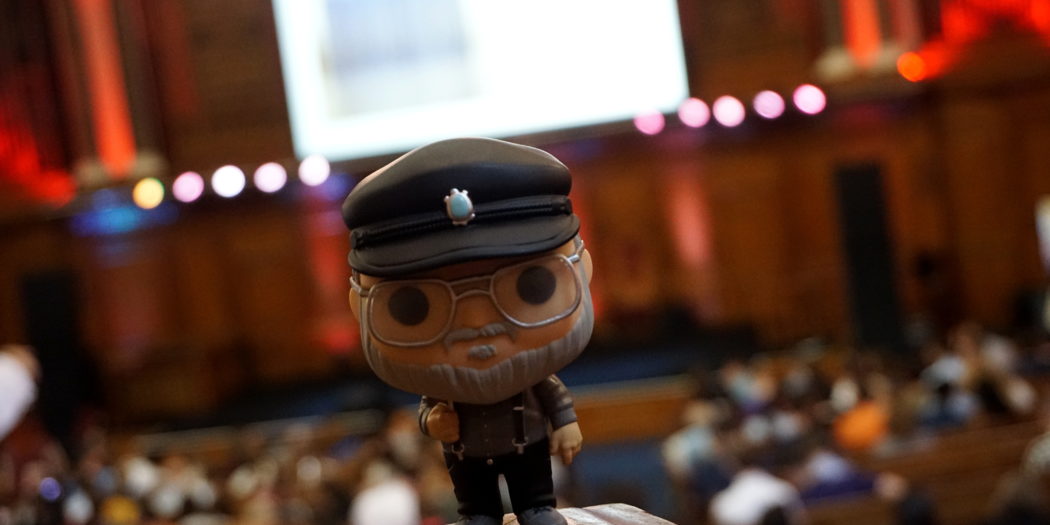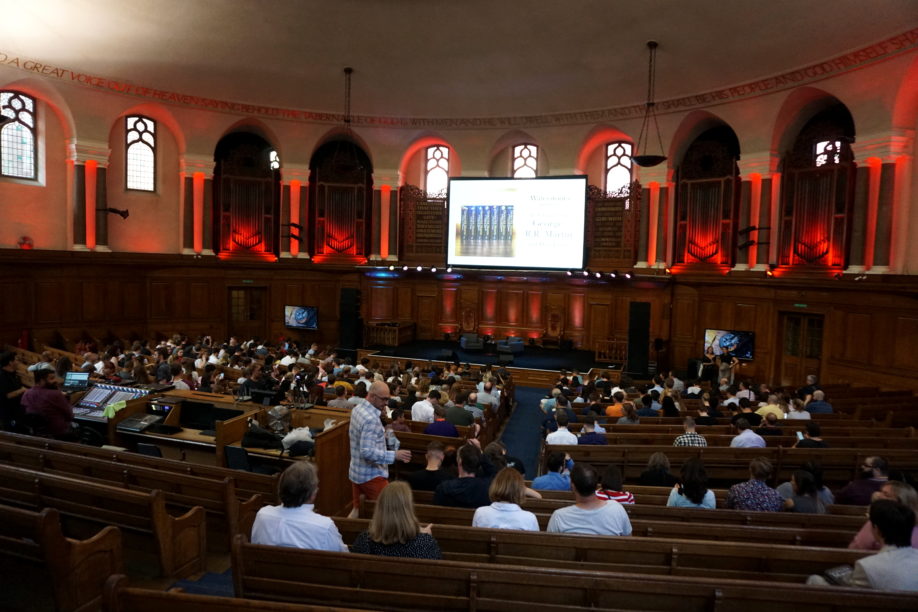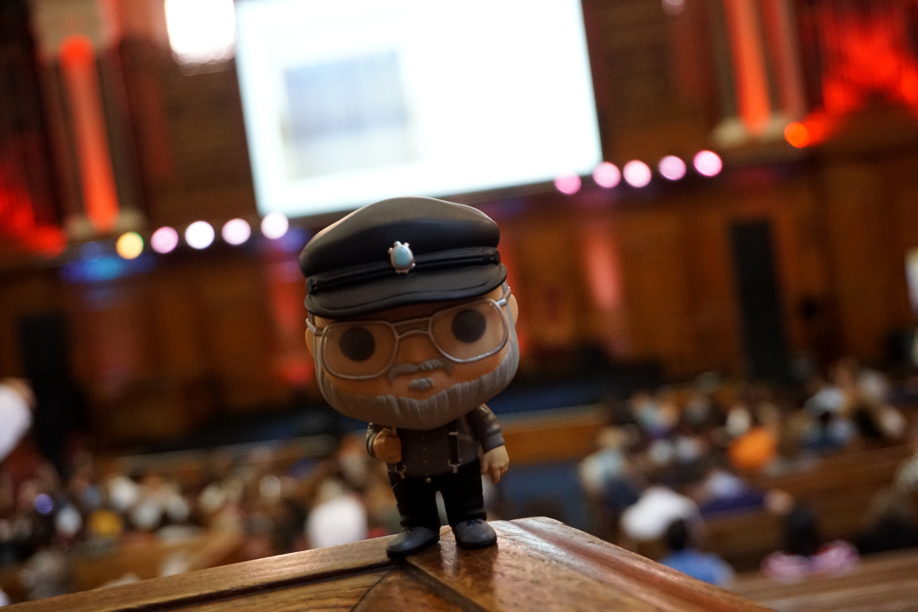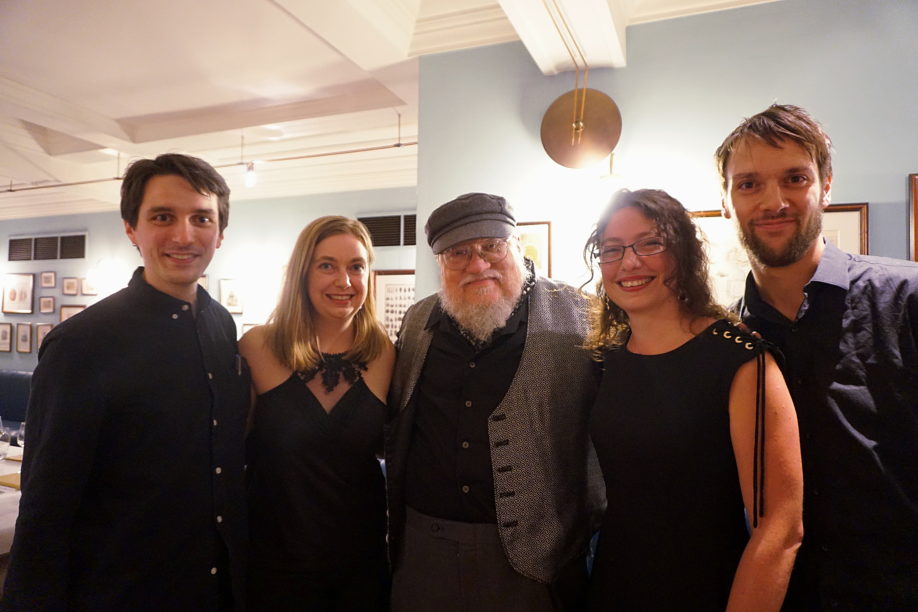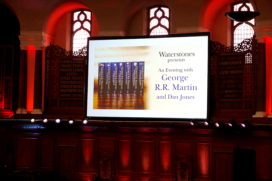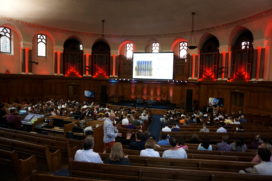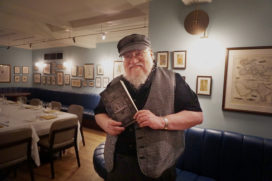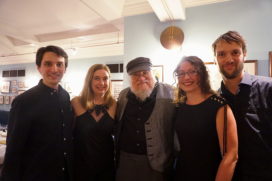Dear international readers. Welcome on the French website La Garde de Nuit. We had the opportunity to meet with George R. R. Martin and thus thought that the informations we gathered might be interesting enough for us to translate it into an article in English (french article is here). Sorry about the remaining mistakes the text might encompass… We hope you enjoy our patrol report ! And if you are learning French, don’t hesitate to go through our website, you’ll find lots of cool articles about ASOIAF 😉
On August 8th, George R. R. Martin was in London for an exceptional evening, organized by the Waterstones bookstore and GRMM’s English publisher, HarperCollins. The event, hosted by historian and writer Dan Jones, took the form of an exciting and lengthy discussion about the novelist’s career, the writing of the A Song of Ice and Fire and his latest book: Fire and Blood.
Some members of the French “La Garde de Nuit” attended this exceptional evening, and even had the opportunity, after the event, to meet very briefly George R.R. Martin, who kindly agreed to give them a few minutes. A big thank you to his teams as well as the teams from Waterstones and HarperCollins for welcoming us so well! Thanks also to Pygmalion (french editor) for putting us in touch.
Here is their patrol report without further delay.
↑An Evening with George R. R. Martin: Discussion at the Emmanuel Center
The event took place in a large wooden amphitheater at the Emmanuel Center (in London’s Westminster district). Two seats are waiting on the stage: one for George R. R. Martin and the other for the one who was going to lead the discussion: Dan Jones, a charismatic British writer, journalist and television presenter specializing in medieval history (author of a bestseller devoted to the Plantagenêts dynasty).
George Martin is used to this kind of « evenings » which oscillate between the interview and the oral performance reminding us of the American talk shows. The members of “La Garde de Nuit” were marked by the ease and fluidity with which he ironicizes and plays with his audience while capturing the audience’s attention, he was very professional in the exercise.
To prepare for the meeting, Waterstones gave the participants of the event the opportunity to send questions in advance. We therefore sent a list of a few questions including what had been proposed on our forum and we were delighted that two of these questions were asked ^^.
The event finally lasted a little over an hour and many topics were covered, from the creation of Westeros to the historical inspirations of his saga, including his Hollywood career, the genesis of Dunk and the Egg short stories and the Fire and Blood book… The vast majority of what Martin said that evening was already known through the author’s many other interviews, but there are some interesting new little details. And what a pleasure to be listening to George R. R. Martin, so comfortable with this kind of exercise!
↑The information we gathered during the meeting
↑The early evening surprise: George R. R. Martin receives two new literary awards
The event began with a small surprise: George R. R. Martin received two Nielsen Bestseller Platinum Awards respectively for A Game of Thrones and A Clash of Kings (the first two books of the main ASOIAF saga). These awards recognize books that have sold more than one million copies in the United Kingdom. By January 2018, only 117 titles (for 77 authors) had received this distinction. Having two books awarded is therefore quite exceptional.
George R. R. Martin, always happy to receive awards, had a thought for the awards he won and (especially) lost during his long career, including the Hugo and Nebula Awards. He reminded us of his friend Gardner Dozois with whom he launched in 1976 – after losing at the Hugo Awards in both categories in which he was nominated – the Hugo losers party that takes place every year at the WorldCon.
The author also took the opportunity to talk about the fantastic journey of the saga in bookshops: thanks to word of mouth, while A Game of Thrones had correct sales but was very far from the list of bestsellers when it was published in 1996, he saw the sales of his novels soar: A Clash of Kings in 1998 had a better start than A Game of Thrones, and earned him for the first time in his career the honours of the famous « New York Times Best Seller list » at its release, the book remaining one week in the list (in 13th position), then A Storm of Swords made even better, A Feast for Crows earned him the first place in the New York Times Best Seller list and stayed there for several weeks… and then the TV show made sales explode again.
« I had no idea that the books would do so well. I hoped that the books would be well received, that they would sell enough for me to continue to write them, and that people would like them. And thankfully they did. »
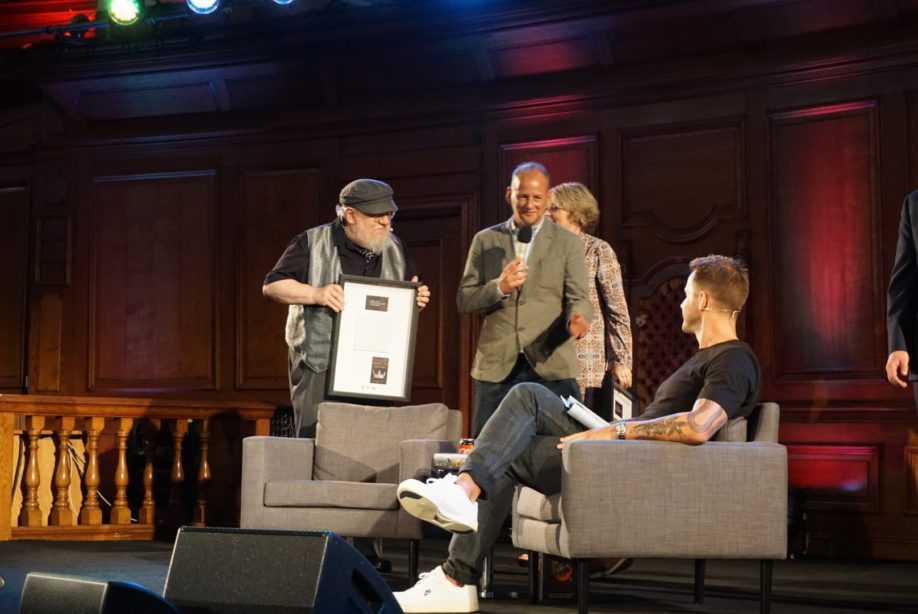
George R.R. Martin and the Nielsen Bestseller Awards – London (Emmanuel Center), August 2019 (© Photo by La Garde de Nuit)
↑Building Westeros
In the summer of 1991, George R. R. Martin was writing Avalon, a science fiction novel set in the world of the Thousand Worlds, when the chapter where Bran discovers wolves in the snow came to his mind. He didn’t know what he had in mind: a short story, a standard novel, a saga… but one thing was certain: he had to put this scene on paper.
A few words immediately rang in his ears: « the summer snows ». It is this phrase, striking and clear in his mind without him knowing where the inspiration came from, that led him to the idea of the deregulation of the seasons in Westeros.
The next chapters then came very quickly. And Westeros’ story was built as he created characters and links between the characters. In the second chapter he wrote, a king arrived, King Robert. But where did he come from? How did he get on the throne, etc…. At some point, he thought he would need a map. He had a map of Ireland, put it upside down and had his first map of Westeros. Then, little by little, he added elements to his map, and thus, the continent of Westeros was born. And the same goes for dynasties and elements of history: the elements gradually came to him as he wrote.
Thus, when he creates a character, George R. R. Martin never creates it alone, but in a context (the environment in which he lives, his relationships with pre-existing characters). He writes not only a book, but a set of 12 intertwined novels (through each Point of View character), which, combined together, form a story.
In the summer of 1991, George R. R. Martin finally wrote a hundred pages of his history. Then he was called to work on TV series scripts in Hollywood. He did not return to his writing work until about three years later, but when he took up his notes again, everything was still fresh in his mind (unlike Avalon, who he realized had no idea where he was going with the story).
It’s been a simultaneous process. I wrote that first chapter […]. I had some vague sense and then when I went to second chapter, a king is coming, where is he coming from? At some point in that process I said “mmmh I’d better have a map » so, I got out a piece of typing paper and, initially I found a map of Ireland and turned it upside down.
↑Working environment
The discussion that followed started with one question we had sent :
How is your workspace organized to write ASOIAF? For instance, do you have a cork board like in police investigations where you wrote all the Targaryens and Freys genealogies?
To our great regret, we learned that, no, George does not have a cork board where he wrote everything down. However, he printed all of TLOIAF’s maps and posted them in his office. But most of the information he has about the saga is in his head. He has a few files on his computer summarizing important information that he has compiled over the years and that he sometimes consults. But for the most part, it’s all in his head. And in case of doubt, thank God for the « search and replace » function of his computer which allows him to return to the initial information.
But even George R. R. Martin is not immune to error: He laughs as he explains that he has hardcore fans (our colleagues from westeros.org certainly ^^, (we do the same for the french language ahah!)) who regularly point out his little mistakes. He has a lot of trouble with the eye colors for some characters and he famously changed the gender of a horse over the pages (it’s an anecdote he likes to tell, and it concerns a priori Bran’s horse who has changed sex over the pages).
Fortunately, in the age of computers, we have search and replace function.

George R.R. Martin and Dan Jones – London (Emmanuel Center), August 2019 (© Photo by La Garde de Nuit)
↑ASOIAF in general
As is often the case when asked about his writing, George R. R. Martin spoke of the figure of the writer-architect he opposes to the writer-gardener. He himself says that he is at 97% a gardener: he plants the seeds of his history, he knows which species he has planted, but he waits to see how the story evolves. Sometimes it works, sometimes it doesn’t.
He says it’s something he thinks he has in common with Tolkien. And just as Tolkien began his account of the Lord of the Rings with all his characters together in one place, separating them as they progressed through their adventures and gradually expanding his world, George R. R. Martin tends to do the same with his characters (except Daenerys): all are present in Winterfell at the beginning, but we then follow them separately.
He admits that his « gardener » side sometimes did not served him well: he had to rewrite several versions of some chapters, realizing that he was at a dead end. He keeps these versions on his computer, for if he can finally integrate them further into the story. One day, he may think about publishing them. In particular, in ADWD, as far as Tyrion was concerned, he had made a chapter where, along his journey on the Rhoyne, Tyrion met the shrouded lord. He was particularly proud of this chapter, which he found excellent. But it didn’t work too well with the rest of the story, so he changed the version. He tried to make it a sequence in which Tyrion met the shrouded lord in a dream, then in a series of several dreams. But it still didn’t work, so he gave up on the idea (on the other hand he kept the idea of the dream, Tyrion dreams a lot in ADWD).
When asked if there were scenes he particularly liked in retrospect because they were very amusing to write, he also replied that surprisingly, they were not the ones you would expect at all. For example, he can be pleased to have described the grass on the prairie perfectly. But the scenes he remembers most are the ones he had trouble writing. And the Red Wedding in particular was very complicated to write for him: it was the very last scene he wrote when he wrote ASOS, the scene making him so sad.
Last question was: if he had to ride a dragon and carry a sword, which one would it be? He replied that he would like to ride the most powerful dragon of all, Balerion, but that he would not want to wield a Targaryan sword, but rather to brandish Dawn, a sword forged from the heart of a meteorite… which could have magical properties who knows ^^^ (*But George, you do know!!!! So??? So??? Does Dawn have magical powers?)
« Who knows what magical properties fallen stars bring to earth ? »
↑Dunk and Egg
Martin also talked about the genesis of the adventures of Dunk and Egg. The first short story was published in 1998 in Legends, edited by Robert Silverberg. At the time Martin was contacted to be part of the anthology, he had only released AGOT in his universe, and did not have the reputation he has today. So it was a big project for him, because he was going to appear alongside big names like Terry Pratchett, Stephen King, Tad Williams, Ursula le Guin, Robert Jordan (Robert Silverberg himself being a prominent figure in the SF/fantasy circles of the time) and because he was going to receive a big advance to write his story. The theme of the anthology was to make an original short story set in the fantasy worlds of each author (the Dark Tower for Stephen King, the books of the Discworld for Pratchett, the Wheel of Time for Jordan, the Krondor chronicles for Raymond E. Feist…). Martin was writing ACOK at that time, so he was wondering what subject and character he was going to write about. He didn’t want to write about a contemporary character from the saga being written, so he opted for a prequel. As a big tournament fan (he loves reading about tournaments), he then chose to tell about a tournament. Thus was born Dunk and the Egg.
The funny anecdote is that since he was late for ACOK, and Silverberg couldn’t afford a delay for his anthology, he almost fired Martin and considered replacing him with another author he had already contacted. But Martin basically said to him, « ah no no no no no. We have a contract! I’ll be on this anthology! I’m not late yet! You’ll see I’ll be on time! ». And Martin did indeed deliver his short story on time (and ACOK was released the following year), on the final day for delivery, December 31. And he was not the only author to play with the deadline, since five other texts were delivered on that day. This explains why there are 11 authors in this anthology, compared to the 10 initially planned. Martin thinks that this anthology has largely contributed to the popularity of his saga, because ACOK’s sales have been better than for AGOT (and it can be seen in the UK: ACOK is the first book for which he had a Nielsen Awards): readers of the anthology, having bought it for an author such as Pratchett or King have read and loved his story and turned to ASOIAF thanks to this.
Martin still has nine stories in mind for Dunk and Egg… But he has to take the time to write them… And before that, he has another little book to finish… You may have heard about it: TWOW. He therefore seems to be considering the following schedule for publication: TWOW then the fourth short story of Dunk and Egg then ADOS – then the next short stories of Dunk and Egg and the second part of Fire and Blood (Of course, Martin can change his mind, this schedule is indicative of what he hopes to publish at the moment. This can change: we saw the example with F&B, which was not planned and was finally published before TWOW. No date is advanced for any of these works.)
↑Wild cards
« Shakespeare move over : Stan Lee has arrived »
Briefly, Martin went back to the genesis of the Wild Cards series: In the early 80’s, being a big fan of comic books, he played with a few friends the role-playing game « Superworlds » (centered on superheroes) in a rather obsessive way (sometimes up to three times a week) and he realized one day that as authors, it should be nice if they tried to make money out of these shared stories (in this sense, we get a feeling on how GRRM has a very American conception of the author’s job: contrary to the French vision of the bohemian artist-writer, Martin’s profession as an author is his livelihood and he is not shy to talk about that). And so was born the saga Wild Cards, edited by Martin, which now includes 27 volumes, with in addition new volumes announced as well as two television series under development on the American channel Hulu.
↑GRRM’s career in Hollywood and the issue of TV adaptation
Martin’s fourth novel, Armageddon Rag, was such a commercial failure that no one wanted to buy his new books. So he ended up working in Hollywood for 10 years. He spent 5 years on Twilight Zone and Beauty and the beast, and then 5 years making TV pilots. He gradually rose through the ranks, until he almost became a showrunner. That, he says, is one of the reasons he chose to get involved in the GOT series at the beginning of its development: he wanted to see what it feels like to be at the top of the ladder.
The work of a screenwriter was well paid and interesting, he appreciated the emulation that came from working with other authors (whereas the writing profession is quite lonely) and seeing his projects come to life. But Martin still recounts how frustrated he was to see some of his projects abandoned, given the energy he had put into the story, and the emotional investment he had in his characters. Nor did he like it when other people intervened and continued his work, transforming his version of characters and stories. The advantage of being alone in front of his computer screen is that he is the God of his history. In the Hollywood industry, he was a god… in the midst of a pantheon of other gods, and he was just a little god.
I loved it. But here is the other side of the coin : it’s the other f*** people who all have f*** opinions !*laughing*
When asked later about the differences between the saga and the TV series GOT, Martin said he was aware of the need for adaptations: for him, adaptation is telling two versions of the same story, each one being real in its own canon. He used the example of Scarlett O’Hara (Gone with the Wind) who has three children in the novel, and an only daughter in the film: what is the real version? Both and None! And anyway, he reminds us that in « real life », she hasn’t had any children, since she doesn’t exist: she’s only a fictional character… probably a way to remind us that all of this is not very serious. In fact, in GoT, D&D have done a great job, he says. Some things will be the same, others will not.
By contract, he was allowed to write one episode per season, which he did until season 4. Each episode, while it was an adaptation of his own writings, took him nearly a month of work, the time to resume his work in the books and readapt it to the canon of the series and the requirements of its format. After season 4, with the butterfly effect, the differences between books and series had become very important, it was no longer just a matter of adapting his own work but of creating new scenes, and he decided not to continue. An episode would have required him to work for at least 2 months on the subject and he did not feel he had the time for it. Books came first.
↑Historical inspirations
Dan Jones being an author of historical novels and trained as an historian, the theme of GRRM’s historical inspirations was addressed quite lengthy during the meeting.
In general, Martin made it clear: he is not a historian and does not seek to be one at all, academic history seems boring to him. He seeks to tell a « good story », stories with betrayals, murders, poisonings, etc… And for this, he draws on popular stories and historical novels, which are rich in this kind of events. Where history as a discipline will question the existence of a particular anecdote, the romanticized history will present these anecdotes, and that’s what Martin is trying to do: find good turns of events, striking elements, even if, historically, they are not entirely true.
Most of the history I read is popular history. If you actually stumble on an academical history, it will probably put you to sleep.
He has sometimes thought about writing historical novels himself, but the problem with historical novels, according to him, is that you are stuck with the story as it happened, you can’t diverge from it. He prefers having the freedom to invent his own paths, drawing inspiration from historical events while having the latitude to surprise and innovate. For example, speaking of Hadrian’s Wall: he explains that he loved imagining himself, while visiting it, like a terrified soldier waiting for the enemy and the end of the world. Of course, a historian will tell you that the end of the world was only Scottish soldiers, but he used this inspiration to build the Wall of Westeros, a gigantic version of Hadrian’s wall, with an enemy that really brings the end of the world this time.
Martin also mentioned his readings on the War of the Two Roses, one of the greatest inspirations of the saga, but he also says he has been greatly enriched by writings on the Hundred Years’ War, on the Crusades, on the Albigensians, on the history of Scotland (which he recommended to us, because it is incredibly bloodier than what he can write). He quoted Nigel Tranter’s writings in particular. The Red Wedding is an exacerbated vision of the Scottish Black Dinner (which he considers having been further exacerbated in the TV series).
He has also learned a lot about tournaments (he loves it), there are a few in the main saga, and most importantly they are at the heart of the story of the Hedge Knight (the first story of Dunk and Egg).
Among the female characters who inspired him, he cites Eleanor of Aquitaine, but also the female figures of the Italian renaissance. On this occasion, he also quoted an anecdote that he loves (and that we may see again in the saga, he says). The anecdote is attributed to several historical figures, including a great female figure of the Italian Renaissance (Catherine Sforza a priori): during a siege, an enemy holds the eldest son of the ruling couple and threatens to kill him. The lady then shows her genitals: « I can do more, go ahead. ».
Among the historical inspirations he indicated, let us also mention Henry VIII for Aegon IV, Saint Louis for Baelor, and Alexander for Daeron I.
Among the stories that marked him, he also mentions Thomas B. Costain’s cycle on Plantagenets, a book of « popular history » that strongly influenced the writing and content of Fire and Blood.
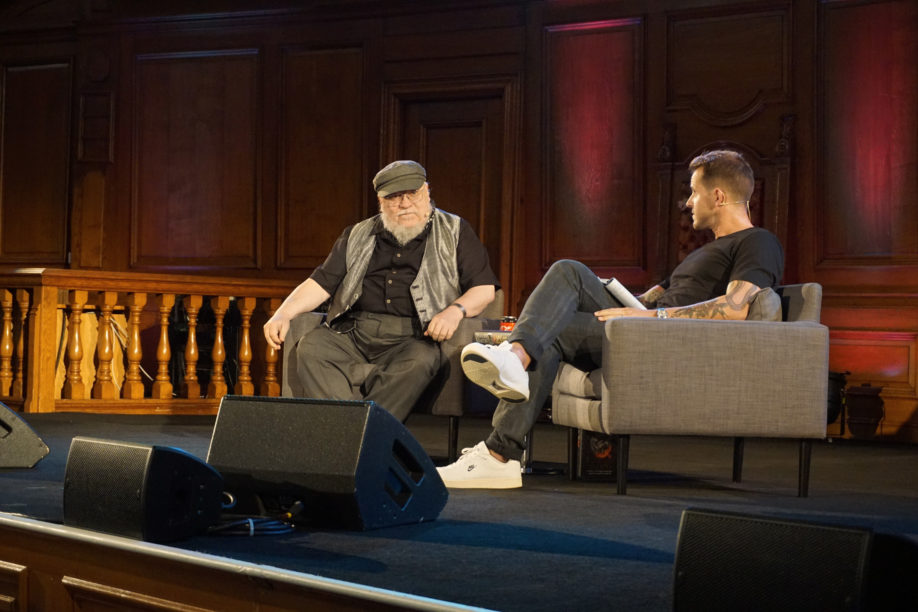
George R.R. Martin and Dan Jones – London (Emmanuel Center), August 2019 (© Photo by La Garde de Nuit)
↑Fire and Blood
One day, the editors of GRR Martin suggested that he write an illustrated encyclopedia of the saga. Martin, a big fan of illustrated books, thus worked on the history of his world with the help of Elio Garcia and Linda Antonsson, administrators of westeros.org. Elio and Linda had to compile the information already existing in the saga, and Martin would then write the missing inserts to complete with new information. The book would be 50,000 words long. But when Elio and Linda finished compiling the information, they already had 70,000 words. And Martin added 350,000 words himself… Obviously not everything could be published.
The vast majority of the texts of Fire and Blood were therefore already written and come from TWOIAF’s overflow of writing (and Martin was quick to write them: writing these texts took him only a few months). Martin had already made good progress throughout the period from the Conquest to the Regency of Aegon III when he and his publishers realized that the inserts were too long to be integrated directly into TWOIAF. When HBO started talking about doing some prequel shows, Martin pulled out his texts, because they could serve as sources and inspirations. He met with his editor: should I finish TWOW first or should I focus on Fire and Blood? Fire and Blood was almost finished, so they chose to finish it first and release it first, so that the text would be published before the possible prequel series.
To publish Fire and Blood, all that was finally missing was the reign of Jaehaerys, a long reign of peace without armed conflict that he had not yet described. When George R. R. Martin started the finishing touches of Fire and Blood, he long wondered what he was going to be able to tell about the reign of Jaehaerys, because it is the longest of the Targaryan reigns and he did not see himself depict forty years of peace, prosperity and abundance at the risk of being boring. He had to invent new things to complete this part, focusing on family dramas that balanced with the surrounding peace.
George R. R. Martin says that he wanted, with Fire and Blood, to do as Thomas B. Costain did with his story of the Plantagenets (which he strongly recommends): to tell a popular story. It is therefore a fictional history book, written in the manner of a « popular history » book. And he says he had a lot of fun taking the pen of Archimaster Gyldayn to tell his story: he didn’t want a story where he said « this is what happened » but on the contrary, he went in the shoes of an in-universe maester who consults divergent sources and tries to deduce the course of events. On this subject, Martin tells an anecdote: years ago, for a novel (which was never finished nor published), he planned to place his story in New York in the 1880s at the heart of the American press world. In particular, he researched « The New York World », a newspaper that was run by Joseph Pulitzer. In 1890, Pulitzer had the New York World Building built, which for four years was the tallest building in the world. This building has since been destroyed, but Martin asked about its number of floors. He came up with three versions: in each of the sources, there were a different number of floors (20, 15 or 16 floors). And that marked him: if for an objective observation of a relatively recent building, there are three different versions of history, what about events that took place in Charlemagne’s time? It was with this in mind that he thought of the story of Westeros and chose to tell it through the eyes of a universe maester.
His favorite character in Fire and Blood is Mushroom. He says he had a lot of fun writing with his voice, because he has the most scandalous and sulphurous version of history.
↑Fire and Blood: what’s next ?
Second question that we had sent and to which Martin was invited to answer :
The second volume of Fire and Blood won’t come out any time soon, but could you give us some elements it might contain?
Martin confirms that nothing is written, but he already has a lot on his mind. Among the characters he developed a little: Aegon III (the death of the dragons, the rebellions during his reign), Daeron whom he compared to Alexander the Great, Baelor whom he compared to Saint Louis, Aegon IV and his 9 mistresses (compared to Henry VIII and his 6 wives), the Blackfyre rebellions, Aerys II and Robert’s rebellion. He does not plan to write it before the end of the main saga a priori.
↑Prequels
Martin mentioned the prequels to the HBO series. The pilot of the most advanced project has recently been completed (in Northern Ireland and Italy). The official title of the future series is not yet known, but it is referred to by HBO as « Bloodmoon » (which is perhaps a working title, or the title of the pilot episode), but Martin himself calls it The Long Night or The Longest Night.
Two other projects are also well advanced, and perhaps one pilot will be shot for one or both of them (as a reminder, there were five projects originally, and one was definitely abandoned). He once again stated that one of these projects is related to the publication of Fire and Blood, but that he could not say what it was about.
↑Meeting GRRM
We were able to meet George R. R. Martin (hiiiiiii !) just after the conference. It was expected to be quick, Martin already having a dinner planned. But he still took the time to come and see us. His teams, in collaboration with the British teams of HarperCollins and Waterstones, had lovingly prepared a small table for us a little far away, which Martin came to sit at (hiiiiiiiiiiiiiiiiiiiiiiiiiiiiii). We exchanged bread and salt (coke and water, same thing^^). We’re not going to lie to you: we were a little (very) impressed, we stammered a lot… but what a thrill we had! About fifteen minutes with Martin, it was already unexpected!
First of all, we gave him 7 gifts: a USB drive containing the vows of the Night’s Watch that we had recorded for him during the celebration of the association’s 10th anniversary (Some context : The last time we saw Martin, in Dijon in 2014, he asked us to recite our vows since we are the Night’s Watch… big blank… Hence this video for him… fortunately he didn’t remember this part, and from Dijon he especially remembered the fact that he had dedicated 4-5 hours ^^), Thierry Soulard’s essay (which « La Garde de Nuit » recommends !) “Les mots sont du vent”, so that Martin has in his library the first book in French devoted exclusively to his books, champagne and macaroons (French represent^^), two history books (we hope he will not classify them in the boring academic category^^) and lead soldiers. And we told him how important he and his amazing work have had on our lives (the creation of the community, the links between members).
He then asked us a question:
“I have a question for you guys : Did they fix the « Loup-garou » issue in the French edition?!”
… Oops xD. Here is a debate that will have caused a lot of ink to flow on the French forums : direwolves are translated into the French word for werewolves (« Loup-garou »), and the author has therefore decided: he finds that « werewolf » is not okay at all ^^ He confided to us that he took as inspiration for the « direwolf » a giant wolf whose species really existed… nothing to do with the « werewolves » therefore. Unfortunately, the original species does not have a French name (we are talking about Canis dirus, literally « sinister wolf ») and we found ourselves in France with a translation that can be politely described as questionable… We have nevertheless reassured him by assuring him that although the translation has not been corrected in the French text, it is nevertheless avoided by many revolutions in the most recent volumes. The translator of the saga, Patrick Marcel, who took over the translation after Jean Sola translated the first volumes, avoids the term « werewolf » by simply talking about « wolf ».
George R. R. Martin then comforted us by explaining that we were not the only ones with funny translations: in the first volume of his saga in Italian, the antler that kills the mother of wolves was translated into a unicorn horn… apparently an antler didn’t sound fantastic enough for Italy ^^.
He was then asked about possible indications he could give to the translators of his saga, based on these misadventures. But he gives no indication to the translators: it would take him too long and since he only speaks English, he does not believe he is in a position to give relevant information on translation issues. Even for his universe, he did not invent a language, but just a few words of High Valyrian and Dothraki. The Dothraki and the High Valyrian were then created for the series and now, if he wants to put words in these languages in his books, he calls his linguist.
He also told us an anecdote about the translation into French of another of his books: a French-speaking fan, a professional translator great lover of his works, had told him that one of his books – one of his first collections of SF short stories – was poorly translated into French. As a result, he made sure that she was the one who translated the next. Finally, when his next book came out and this person translated it, people complained again about the translation… In short, translation, this endless problem, and he prefers not to touch it. ^^
We then asked a question about his historical readings: he read medieval authors (he confirmed that he had read Jean Froissart years ago), but did he read ancient authors? He replied that he had read Suetonius (he probably read others, but he replied about Suetonius), and that he loved it, because his stories were full of poisonings, incest, murder. The character of Mushroom is partly inspired by Suetone. Suetone is also one of the sources that was used for the series I, Claudius, which Martin likes very much. In his eyes, Suetonius is not boring as academic history has told us. And then, following on from his historical readings, he re-affirmed his love for the saga of the Accursed Kings (he couldn’t help but mention Druon to francophones ^^).
We still had many questions to ask, but he was then taken away for dinner:'( He thanked us for coming, and we will always remember how adorable it was on his part to have accepted to take this time. So thank you George, we love you !
And now… see you in Ireland! New French people with their knife-cut accents and glittery eyes await you in Dublin 😉 (and Belfast).
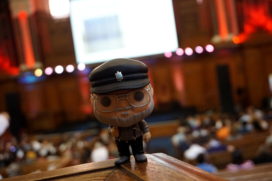
George R.R. Martin (presque !) – Londres (Emmanuel Center), août 2019 (© Photo par La Garde de Nuit)

George R.R. Martin recevant les Nielsen Bestseller Awards – Londres (Emmanuel Center), août 2019 (© Photo par La Garde de Nuit)

George R.R. Martin recevant les Nielsen Bestseller Awards – Londres (Emmanuel Center), août 2019 (© Photo par La Garde de Nuit)
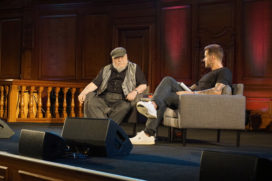
George R.R. Martin et Dan Jones – Londres (Emmanuel Center), août 2019 (© Photo par La Garde de Nuit)
